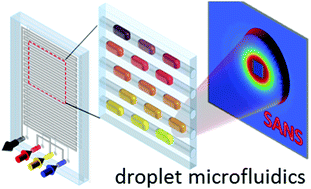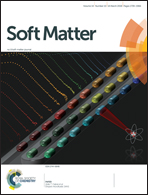Droplet microfluidic SANS†
Abstract
The coupling of droplet microfluidics and Small Angle Neutron Scattering (SANS) is demonstrated with a range of model systems: isotopic solvent (H2O/D2O) mixtures, surfactant (sodium dodecyl sulfate, SDS) solutions and colloidal (silica) suspensions. Several droplet carrier phases are evaluated and fluorinated oil emerges as a suitable fluid with minimal neutron background scattering (commensurate with air), and excellent interfacial properties. The combined effects of flow dispersion and compositional averaging caused by the neutron beam footprint are evaluated in both continuous and droplet flows and an operational window is established. Systematic droplet-SANS dilution measurements of colloidal silica suspensions enable unprecedented quantification of form and structure factors, osmotic compressibility, enhanced by constrained global data fits. Contrast variation measurements with over 100 data points are readily carried out in 10–20 min timescales, and validated for colloidal silica of two sizes, in both continuous and droplet flows. While droplet microfluidics is established as an attractive platform for SANS, the compositional averaging imposed by large (∼1 cm) beam footprints can, under certain circumstances, make single phase, continuous flow a preferable option for low scattering systems. We propose simple guidelines to assess the suitability of either approach based on well-defined system parameters.



 Please wait while we load your content...
Please wait while we load your content...